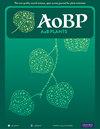与真菌的相互作用在跨降水梯度的雷公藤基因型中有所不同
IF 2.4
3区 生物学
Q2 ECOLOGY
引用次数: 0
摘要
植物相关微生物,特别是真菌内生菌,增强了许多禾本科植物适应极端环境条件的能力。野草是一种多年生、耐旱的草,原产于美国中部的高草草原。dactyloides的微生物组对其耐旱性的贡献程度尚不清楚。从堪萨斯州、俄克拉荷马州和德克萨斯州的东西降水梯度的本地种群中收集了97种基因型的短叶菊,然后在一个共同的花园里种植了20多年。根和叶样品目测真菌密度。由于真菌内生菌赋予寄主植物耐旱能力,我们预计在西部干旱地区的植物中发现的真菌内生菌密度要高于东部湿润地区的植物。结果证实,根内生菌密度与基因型原生地降水呈负相关(r = -0.21 p=0.04)。我们的分析表明,宿主基因型沿降水梯度的起源预测了根中共生体的绝对丰度,但不能预测特定生物的相对丰度或整体群落组成。综上所述,这些结果表明植物-微生物相互作用的遗传变异可以反映历史环境,并加强了在高草草原生态系统保护和恢复工作中考虑植物基因型的重要性。本文章由计算机程序翻译,如有差异,请以英文原文为准。
Interactions with fungi vary among Tripsacum dactyloides genotypes from across a precipitation gradient
Abstract Plant-associated microbes, specifically fungal endophytes, augment the ability of many grasses to adapt to extreme environmental conditions. Tripsacum dactyloides (Eastern gamagrass) is a perennial, drought tolerant grass native to the tallgrass prairies of the central United States. The extent to which the microbiome of T. dactyloides contributes to its drought tolerance is unknown. Ninety-seven genotypes of T. dactyloides were collected from native populations across an east-west precipitation gradient in Kansas, Oklahoma, and Texas, then grown together in a common garden for over 20 years. Root and leaf samples were visually examined for fungal density. Because fungal endophytes confer drought tolerant capabilities to their host plants, we expected to find higher densities of fungal endophytes in plants from western, drier regions, compared to plants from eastern, wetter regions. Results confirmed a negative correlation between endophyte densities in roots and precipitation at the genotype’s original location (r = -0.21 p=0.04). Our analyses reveal that the host genotype’s origin along the precipitation gradient predicts the absolute abundance of symbionts in the root, but not the relative abundances of particular organisms nor the overall community composition. Overall, these results demonstrate that genetic variation for plant-microbe interactions can reflect historical environment, and reinforce the importance of considering plant genotype in conservation and restoration work in tallgrass prairie ecosystems.
求助全文
通过发布文献求助,成功后即可免费获取论文全文。
去求助
来源期刊

AoB Plants
PLANT SCIENCES-
CiteScore
4.80
自引率
0.00%
发文量
54
审稿时长
20 weeks
期刊介绍:
AoB PLANTS is an open-access, online journal that has been publishing peer-reviewed articles since 2010, with an emphasis on all aspects of environmental and evolutionary plant biology. Published by Oxford University Press, this journal is dedicated to rapid publication of research articles, reviews, commentaries and short communications. The taxonomic scope of the journal spans the full gamut of vascular and non-vascular plants, as well as other taxa that impact these organisms. AoB PLANTS provides a fast-track pathway for publishing high-quality research in an open-access environment, where papers are available online to anyone, anywhere free of charge.
 求助内容:
求助内容: 应助结果提醒方式:
应助结果提醒方式:


